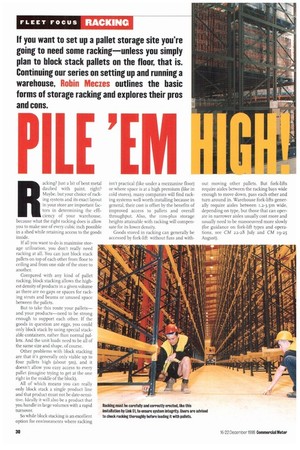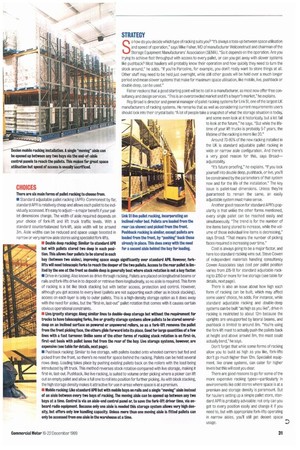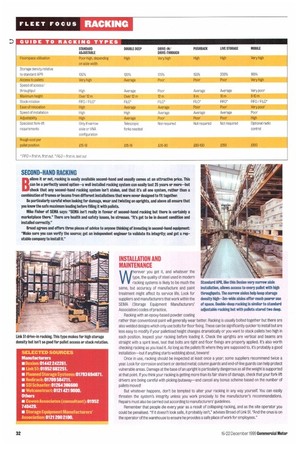If you want to set up a pallet storage site
Page 32

Page 33

Page 34

If you've noticed an error in this article please click here to report it so we can fix it.
you're going to need some racking—unless you simply plan to block stack pallets on the floor, that is. Continuing our series on setting up and running a warehouse, Robin Meczes outlines the basic forms of storage racking and explores their pros and cons.
Racking? Just a bit of bent metal daubed with paint, right? Maybe, but your choice of racking system and its exact layout in your store are important factors in determining the efficiency of your warehouse, because what the right racking does is allow you to make use of every cubic inch possible in a shed while retaining access to the goods inside.
If all you want to do is maximise storage utilisation, you don't really need racking at all. You can just block stack pallets on top of each other from floor to ceiling and from one side of the store to another.
Compared with any kind of pallet racking, block stacking allows the highest density of products in a given volume as there are no gaps or spaces for racking struts and beams or unused spate between the pallets.
But to take this route your pallets— and your products—need to be strong enough to support each other. If the goods in question are eggs, you could only block stack by using special stackable containers, rather than normal pallets. And the unit loads need to be all of the same size and shape, of course.
Other problems with block stacking are that it's generally only viable up to four pallets high (about 5m), and it doesn't allow you easy access to every pallet (imagine trying to get at the one right in the middle of the block).
All of which means you can really only block stack a single product line and that product must not be date-sensitive. Ideally it will also be a product that you handle in large volumes with a rapid turnover.
So while block stacking is an excellent option for environments where racking isn't practical (like under a mezzanine floor) or where space is at a high premium (like in cold stores), many companies will find racking systems well worth installing because in general, their cost is offset by the benefits of improved access to pallets and overall throughput. Also, the rim-plus storage heights attainable with racking will compensate for its lower density.
Goods stored in racking can generally be accessed by fork-lift without fuss and with
out moving other pallets. But fork-lifts require aisles between the racking bays wide enough to move down, pass each other and turn around in. Warehouse fork-lifts generally require aisles between 1.2-3.5m wide, depending on type, but those that can operate in narrower aisles usually cost more and usually need to be manoeuvred more slowly (for guidance on fork-lift types and operations, see CM 22-28 July and CM 19-25 August).
CHOICES There are six main forms of pallet racking to choose from.
• Standard adjustable pallet racking (APR): Commonest by far, standard APR is relatively cheap and allows each pallet to be individually accessed. It's easy to adjust—a major benefit if your pallet dimensions change. The width of aisle required depends on your choice of fork-lift and lift truck traffic levels. With a standard counterbalanced fork-lift, aisle width will be around 3m. Aisle widths can be reduced and space usage boosted in narrow or very narrow aisle stores using specialist fork-lifts.
• Double deep racking: Similar to standard APR but with pallets stored two deep in each position. This allows four pallets to be stored in each bay (between two aisles), improving space usage significantly over standard APR. However, forklifts will need telescopic forks to reach the deeper of the two pallets. Access to the rear pallet is limited by the one at the front so double deep is generally best where stock rotation is not a key factor. II Drive-in racking: Also known as drive-through racking. Pallets are placed on longitudinal beams or rails and fork-lifts drive in to deposit or retrieve them longitudinally, so no aisle is required. This form of racking is a bit like block stacking but with better access, protection and control. However, although you get access to every level (pallets are not supporting each other as in block stacking), access on each layer is only to outer pallets. This is a high-density storage option as it does away with the need for aisles, but the "first-in, last-out" pallet rotation that comes with it causes certain obvious operational constraints.
• Live/gravity storage: Along similar lines to double-deep storage but without the requirement for trucks to have telescoping forks, live or gravity storage systems allow pallets to be stored severaldeep on an inclined surface on powered or unpowered rollers, so as a fork-lift removes the pallet from the front picking face, the others glide forward into its place. Good for large quantities of a few lines with a fast turnover. Unlike some of the other forms of racking stock rotation is on first-in, first-out basis with pallet lanes fed from the rear of the bay. Live storage systems, however, are expensive (see table for details, next page).
• Pushback racking: Similar to live storage, with pallets loaded onto wheeled carriers but fed and picked from the front, so there's no need for space behind the racking. Pallets can be held several rows deep. Loading takes place by pushing existing pallets back on the rollers with the load being introduced by lift truck. This method reverses stock rotation compared with live storage, making it first-in, last-out. Pushback, like live racking, is suited to volume order picking where a picker can lift out an empty pallet and allow a full one to roll into position for further picking. As with block stacking, the high storage density makes it attractive for use in areas where space is at a premium.
• Mobile racking: Like standard APR but with mobile bays on rails and a single "moving" aisle instead of an aisle between every two bays of racking. The moving aisle can be opened up between any two bays at a time. Control is via an aisle-end control panel or, to save the fork-lift driver time, via onboard radio equipment Because only one aisle is needed this storage system allows very high density, but offers only low handling capacity. Unless more than one moving aisle is fitted pallets can only be accessed from one aisle in the warehouse at a time. STRATEGY So how do you decide which type of racking suits you? "It's always a toss-up between space utilisation and speed of operation," says Mike Fisher, MD of manufacturer Welconstruct and chairman of the Storage Equipment Manufacturers' Association (SEMA). "So it depends on the operation. Are you trying to achieve fast throughput with access to every pallet, or can you get away with slower systems like pushback? Most hauliers will probably know their operation and how quickly they need to turn the stock around," he adds. "If you're Parceline, for example, you don't really want to store things at all. Other stuff may need to be held just overnight, while still other goods will be held over a much longer period and mean slower systems that make for maximum space utilisation, like mobile, live, pushback or double deep, can be used."
Fisher reckons that a good starting point will be to call in a manufacturer, as most now offer free consultancy and design services. "This is an overcrowded market and it's a buyer's market," he explains.
Roy Broad is director and general manager of pallet racking systems for Link 51, one of the largest UK manufacturers of racking systems. He remarks that as well as considering current requirements users should look into their crystal balls: 'A lot of people take a snapshot of what the storage situation is today, and some even look at it historically, but a lot fail to look at the future," he says. "But while the lifetime of your lift trucks is probably 5-7 years, the lifetime of the racking is more like 20."
Around 70-80% of the new racking installed in the UK is standard adjustable pallet racking in wide or narrow aisle configuration. And there's a very good reason for this, says Broadadjustability.
"It's future-proofing," he explains. "If you lock yourself into double deep, pushback, or live, you'll be constrained by the parameters of that system now and for the life of the installation." The key issue is pallet-load dimensions. Unless they're guaranteed to remain the same, an easily adjustable system must make sense.
Another good reason for standard APR's popularity is that unlike the other forms mentioned, every single pallet can be reached easily and simultaneously. "The trend is for the number of line items being stored to increase, while the volume of those individual line items is decreasing," says Broad. "That means the number of picking faces required is increasing over time."
Cost is always going to be a major factor, and here too standard racking wins out. Steve Cowen of independent materials handling consultancy Cowen Associates says cost per pallet position varies from 115-18 for standard adjustable racking to £150 or more for live storage (see table for details, next page).
There is also an issue about how high each form of racking can be built, which may affect some users' choice, he adds. For instance, while standard adjustable racking and double-deep systems can be built "as high as you like", drive-in racking is restricted to about 12m because the uprights are unsupported by lateral beams, and pushback is limited to around 8m. "You're using the fork-lift mast to actually push the pallets back at height and above around 8m, the mast could actually bend," he says.
Don't forget that while some forms of racking allow you to build as high as you like, fork-lifts don't go much higher than 12m. Specialist equipment, like crane systems, can cater for higher levels but this will cost you dear.
There are good reasons to go for some of the more expensive racking types—particularly in environments like cold stores where space is at a premium and storage density is paramount. But for hauliers setting up a simple pallet store, standard APR is probably advisable: net only can you get to every position easily and change it if you need to, but with appropriate fork-lifts operating in narrow aisles, you'll still get decent space usage.
SECOND-HAND RACKING Believe it or not, racking is easily available second-hand and usually comes at an attractive price. This can be a perfectly sound option—a well installed racking system can easily last 25 years or more—but check that any second-hand racking system isn't stolen, and that it's all one system, rather than a combination of frames or beams from different installations that were never designed to fit together.
Be particularly careful when looking for damage, wear and twisting on uprights, and above all ensure that you know the safe maximum loading before filling it with pallets.
Mike Fisher of SEMA says: ''SEMA isn't really in favour of second-hand racking but there is certainly a marketplace there." There are health and safety issues, he stresses. It's got to be in decent condition and installed correctly."
Broad agrees and offers three pieces of advice to anyone thinking of investing in second-hand equipment: "Make sure you can verify the source; get an independent engineer to validate its integrity; and get a reputable company to install it."
INSTALLATION AND MAINTENANCE Wherever you get it, and whatever the type, the quality of steel used in modern racking systems is likely to be much the same, but accuracy of manufacture and paint treatment might affect its service life. Look for suppliers and manufacturers that work within the SEMA (Storage Equipment Manufacturers' Association) codes of practice.
Racking with an epoxy-based powder coating rather than conventional paint will generally wear better. Racking is usually bolted together but there are also welded designs which only use bolts for floor fixing. These can be significantly quicker to install but are less easy to modify if your palletload height changes dramatically or you want to stack pallets two high in each position. Inspect your racking before loading it. Check the uprights are vertical and beams are straight with a spirit level, test that bolts are tight and floor fixings are properly applied, it's also worth checking racking as you load it. As long as the pallets fit where they are supposed to, it's probably a good installation—but if anything starts wobbling about, beware!
Once in use, racking should be inspected at least once a year; some suppliers recommend twice a year. Look for corrosion and bent or dented metal; column guards and end-of-line guards can help protect vulnerable areas. Damage at the base of an upright is particularly dangerous as all the weight is supported at that point. If you think your racking is getting more than its fair share of damage, check that your fork-lift drivers are being careful with picking/putaway—and cancel any bonus scheme based on the number of pallets moved!
But whatever happens, don't be tempted to alter your racking in any way yourself. You can easily threaten the system's integrity unless you work precisely to the manufacturer's recommendations. Repairs must also be carried out according to manufacturers' guidelines.
Remember that people die every year as a result of collapsing racking, and as the site operator you could be penalised. "If it doesn't look safe, it probably isn't," advises Broad of Link 51. "And the onus is on the operator of the warehouse to ensure he provides a safe place of work for employees." SELECTED SOURCES Manufacturers
• Elexion:01442 242261.
• Link 51:01952682251.
• Planned Storage Systems 01793 694871.
• Redirack:01709 584711.
• SSI Schaefer: 01264 386600
• Welconstruct: 0121 421 9000. Others • Cowen Associates (consultant): 01952 740429.
w Storage Equipment Manufacturers' Association:0121 2002100.
































































































